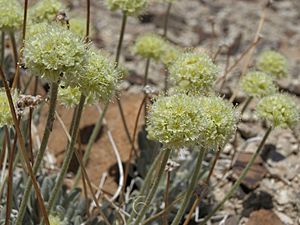Eriogonum tiehmii facts for kids
Quick facts for kids Eriogonum tiehmii |
|
|---|---|
 |
|
| Conservation status | |
| Scientific classification | |
| Genus: |
Eriogonum
|
| Species: |
tiehmii
|
Eriogonum tiehmii, also known as Tiehm's buckwheat, is a special kind of flowering plant. It only grows in one place in the world: the Silver Peak Range in Esmeralda County, Nevada, United States. This plant is very rare, and its only known home is at risk because of plans for mining nearby. Sadly, a large part of its population was damaged in 2020.
Contents
Discovering Tiehm's Buckwheat
An American plant expert named James L. Reveal officially named this plant in 1985. He named it after Arnold "Jerry" Tiehm, who was the first person to find and collect the plant in 1983.
What Does Tiehm's Buckwheat Look Like?
Tiehm's buckwheat is a small plant that lives for many years. It grows to be about 30 centimeters (12 inches) wide and up to 16 centimeters (6 inches) tall. Its leaves are a pretty blue-grey color. The leaves are about 1 to 2 centimeters long and 5 to 8 millimeters wide. They have soft white or grey hairs on both sides. Sometimes, the top of the leaves lose these hairs as the plant gets older.
Why is Tiehm's Buckwheat in Danger?
Tiehm's buckwheat is considered critically imperiled. This means it is at a very high risk of disappearing forever. This is because there are very few of these plants left, and they are threatened by mining activities. When people explore for mines, it can also bring in unwanted plants that harm the buckwheat's home.
As of 2020, a company called Ioneer planned to open a lithium mine. This mine was expected to destroy about 50% to 70% of all the known Tiehm's buckwheat plants. Because of this, groups that work to protect nature have tried to get the plant federal protection. They also want to stop mining exploration in the areas where it grows.
What Happened to the Plants in 2020?
Between July and September 2020, over 17,000 plants were damaged. This was more than 40% of the entire population. The area where they grew was also badly harmed.
Scientists from the University of Nevada, Reno, and other land management groups, including Ioneer, believe that small animals like rodents caused the damage. They found signs from wildlife surveys and special cameras that support this idea. However, other groups, like the Center for Biological Diversity, and a plant researcher named Benjamin Grady, do not agree. They think the damage was caused by people on purpose.
Later surveys found similar damage to other nearby desert plants. This damage was likely caused by rodents looking for water during a very dry year. Because of this, many people are asking for more protection for the plants. They also want the damaged areas to be fixed and for all mining exploration in the area to be stopped.


